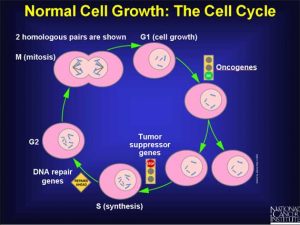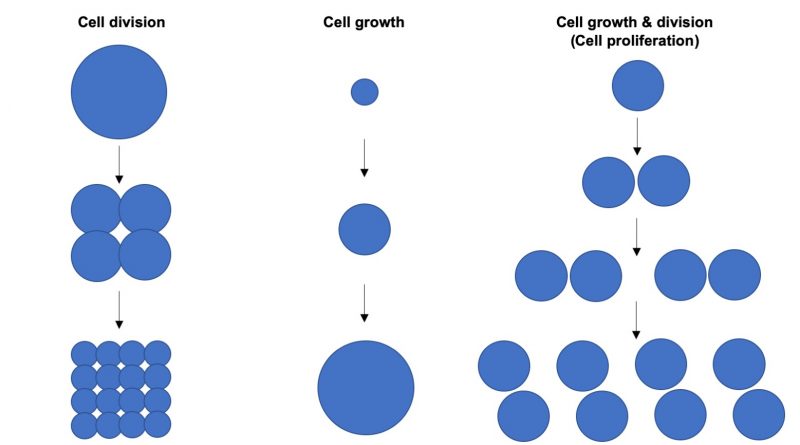Cell growth
Cell growth
In unicellular organisms, cell division is the means of reproduction; in multicellular organisms, it is the means of growth and maintenance of tissues. The survival of eukaryotes depends on interactions between many cell types, and it is essential that a balanced distribution of types be maintained. This is achieved through the highly regulated process of cell proliferation. The cell growth and division of different cell populations are regulated in different ways, but the basic mechanisms are similar in all multicellular organisms.
Most body tissues grow by increasing their number of cells, but this growth is highly regulated to maintain a balance between the different tissues. In adults, most cell division is involved in tissue renewal rather than growth, and many cell types undergo continual replacement. Skin cells, for example, are constantly being shed and replaced; in this case, the mature differentiated cells do not divide, but their population is renewed by the division of immature stem cells. In some other cells, such as those in the liver, mature cells are still capable of dividing to allow growth or regeneration after injury.
In contrast to these patterns, other types of cells cannot divide or certain molecules produced by nearby cells prevent them from dividing. As a result, in the adult organism, some tissues have a greatly reduced ability to renew damaged or diseased cells. Examples of such tissues include heart muscle, nerve cells of the central nervous system, and lens cells in mammals. Maintenance and repair of these cells are limited to replacing intracellular components rather than replacing entire cells.
Duplication of genetic material
Before a cell can divide, it must accurately and completely duplicate the genetic information encoded in its DNA for its progeny cells to function and survive. This is a complex problem due to the great length of DNA molecules. Each human chromosome consists of a long double coil, or helix, each strand consisting of more than 100 million nucleotides.
DNA duplication is called DNA replication and is initiated by complex enzymes called DNA polymerases. These move along the molecule, reading the sequences of nucleotides that come together to form DNA strands. Each strand of the DNA double helix, therefore, acts as a template that specifies the nucleotide structure of a new, growing strand. After replication, each of the two daughter DNA double helices consists of a parent DNA strand coiled around a newly synthesized DNA strand.
For DNA to replicate, the two strands must unwind from each other. Enzymes called helicases unwind the two strands of DNA, and additional proteins bind to the separated strands to stabilize them and prevent them from pairing up again. Additionally, a remarkable class of enzyme called DNA topoisomerase removes helical turns by cutting one or both strands and then resealing the cut. These enzymes can also unravel and unknot DNA when it is tightly coiled in a chromatin fibre. In the circular DNA of prokaryotes, replication begins at a single site called the origin of replication and then proceeds in both directions around the molecule until the two processes meet, producing two daughter molecules.
In fast-growing prokaryotes, the second round of replication can begin before the first is finished. The situation in eukaryotes is more complicated since replication is slower than in prokaryotes. At 500 to 5,000 nucleotides per minute (versus 100,000 nucleotides per minute for prokaryotes), it would take about a month for a human chromosome to replicate if it started at a single site. In reality, replication begins at many sites on the long chromosomes of animals, plants, and fungi. The distances between adjacent initiation sites are not always the same; for example, they are closer together in the embryonic cells of rapidly dividing frogs or flies than in the adult cells of the same species.
Normal cell growth
To illustrate this process, let’s look at the cells of the epidermis (the outermost layer of the skin). The outer layer of skin is about two dozen cells thick. Under normal circumstances, cells at the bottom of this layer called the basal layer, divide at exactly the same rate as dead cells shed from the surface. Every time one of these basal cells divides, it produces two cells. One remains in the basal layer and continues to divide again. The other migrates out of the basal layer and can no longer divide. In this way, the number of dividing cells in the basal layer and the number of non-dividing cells in the outer layer remain the same.

For this process to unfold so precisely, 2 important cellular processes must be perfectly balanced:
- Proliferation
- apoptosis
Proliferation refers to the growth and reproduction of cells. Apoptosis (cell suicide) is the mechanism by which old or damaged cells normally self-destruct. If these carefully balanced processes are disrupted and cells proliferate out of control, don’t die at the right time, or both, the end result can be cancer.
Abnormal cell growth
In order for the body’s tissues to maintain such precise control over the growth of its cells, it has developed a system of feedback loops that detect and compensate for deviations from the norm. For each situation controlled by a feedback loop, the body has a set point that it recognizes as normal. An example of this is your own body temperature. If your body temperature gets too hot, a series of physiological reactions are triggered in an effort to restore it. If your body temperature becomes too cold, a different set of reactions is triggered to warm you up.
This is an example of a negative feedback loop. In a positive feedback loop, changes in one direction tend to produce even more changes in that same direction, like the stages of labour leading up to delivery. In the case of normal cell proliferation, when the right number of cells have been produced (and the cells begin to crowd each other), growth inhibitory factors activate a negative feedback mechanism to reduce the rate of cell growth. Although positive feedback can occur normally, excess growth factor production by cells creates an abnormal positive feedback loop.
Not all cells that grow abnormally are cancerous. For example, the term hyperplasia refers to a type of noncancerous growth that consists of cells that divide rapidly, giving rise to a greater than a usual number of structurally normal cells. Hyperplasia may be a normal tissue response to an irritating stimulus. Calluses that form on your hand when you first learn to swing a tennis racket or golf club are an example of hyperplastic skin cells. Although hyperplasia is considered reversible, in some cases it indicates an increased risk of cancer. An example is hyperplasia of the lining of the uterus (endometrium).
Dysplasia is another non-cancerous type of abnormal cell growth characterized by loss of normal tissue arrangement and cell structure. Dysplastic cells lose the normal architecture that characterizes normal tissues and may show physical and chemical changes that distinguish them from their normal counterparts. They may have changes in their DNA, or they may have visible changes in their cell structures (especially the cell nucleus) that can be seen under a microscope. These visible changes are often helpful in detecting dysplasia early, before it progresses, as it sometimes (but not always) leads to cancer.
One example is cervical dysplasia, which can develop into cervical cancer if left untreated for a long period of time. The most severe form of dysplasia, carcinoma in situ, can actually be considered a form of cancer. In Latin, the term “in situ” means “in the place”. Carcinoma in situ refers to the uncontrolled growth of cells that remain in their original location (in place) without invading surrounding tissue, as cancer cells eventually do. However, carcinoma in situ is considered more serious than moderate dysplasia because the risk of local invasion is much higher. That is why, when discovered, carcinoma in situ is usually removed surgically. Image 6 illustrates the different types of growth.

